
However, a study in CyTA - Journal of Food may provide some form of relief: Mixing in oat bran and psyllium husk fiber in the dough before frying them reduces the amount of oil it soaks up. Researchers from the University of Venda in South Africa have tested it by using their own version of a fried dessert called the magwinya.
In particular, magwinya is a deep-fried doughnut that's popular in Botswana and South Africa. While it is unique to South Africa and its neighbors, the fried bread has Dutch origins, in particular, vetkoek, a fat cake. The main difference between the two is that magwinya is eaten alone, but vetkoek is usually cut open and stuffed with cheeses or jams.
However, it's not just doughnuts that are deep-fried in South Africa. According to researchers, deep-fat frying is used in most types of food preparation in the country. This is part, "due to [the] preference of consumers to texture, appearance, and taste of fried products." While deep-fried foods are flavorful, they put a person at a higher risk of adverse health conditions.
In particular, many food establishments around the world use trans fat-containing oil in frying their food, which increases the likelihood of high cholesterol and heart disease. Eating deep-fried food also makes a person a likely candidate for obesity and certain cancers. (Related: Deep fried foods increase risk of developing aggressive prostate cancer by one-third.)
For the current study, they looked at two ingredients to counter this phenomenon. Oats and its bran contain beta-glucan, a compound known to reduce blood cholesterol levels. It also has a high water holding capacity, making it an ideal fat replacement in many dishes. Psyllium husk similarly contains health benefits. The researchers looked at two ways of processing magwinya to determine whether adding the two ingredients will affect not only the amount of oil reduced but also its quality parameters, using response surface methodology to study its physicochemical properties.
Researchers used two methods to prepare magwinya – the traditional and the modified methods. In the traditional method, cake wheat flour (100 g), salt (1 g), sugar (15 g), yeast (1 g), lukewarm water (100 mL) were mixed by hand until it formed a uniformly wet sticky dough. The doughnuts were then formed and fermented for 45 minutes, then deep-fried in the oil for five minutes at 180 C.
The modified method used wheat flour with varying amounts of oat bran and psyllium husk fiber. The cake wheat flour, together with salt (1 g), sugar (15 g), yeast (1 g), and lukewarm water (65 mL), was weighed and combined with other ingredients using an electric mixer. These were then fermented, formed into doughnuts, then deep-fried in oil for three minutes at 180 C.
Based on the results, researchers found that adding the two ingredients significantly reduced the oil content of magwinya. The psyllium husk fiber showed better fat-reducing properties than oat bran, and both affected quality parameters. Researchers also noted that cakes prepared with the modified method were noted to be desirable.
"In general, incorporation of OB (oat bran) and PF (psyllium husk fiber) in traditional magwinya cereal snack reduced oil content, increased total mineral content (ash), reduced hardness and lightness," the researchers concluded. "Sensory properties of OB/PF magwinya may be essential in evaluating the response of consumers to these additives."
Learn more about the benefits of oats by heading to Food.news today.
Sources include:
Please contact us for more information.























